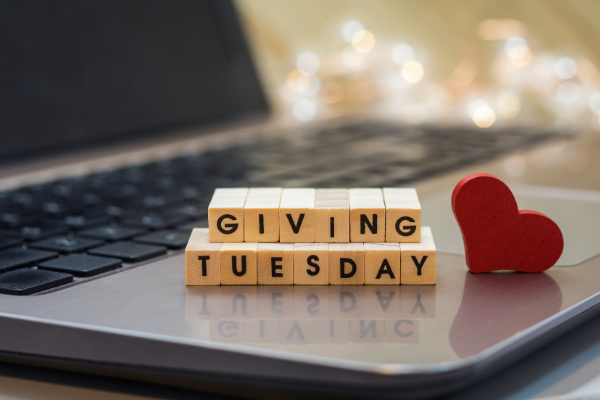Insights
INSIGHTS
All Topics
My Account
Taking Part In Giving Tuesday? Here’s Everything You Need to Know
16 Nov 2020by Aidan Paterson
Giving Tuesday is one of the most important dates in the charity calendar. Here’s how you can make the most of it
This article is sponsored by Salesforce.org - the dedicated social impact team of Salesforce that delivers technology to nonprofits, educational institutions, and philanthropic organisations so they can connect with others and do more good.
Giving Tuesday (often styled as #GivingTuesday on social media) takes place on the 1st of December 2020.
This annual event has gone from strength to strength since its inaugural edition in 2012. Giving Tuesday has quickly become a staple of the charity fundraising calendar.
The movement was created in the US as a response to the commercialisation and consumerism of the lead up to the holiday season - where Giving Tuesday forms part of the post-Thanksgiving period alongside Black Friday and Cyber Monday - and a chance for people to give back in the season of goodwill. The event has been able to spread from the US around the world due to the festive season’s many religious and secular dates highlighting the importance of kindness and giving.
Giving Tuesday can have a big impact on an organisation’s fundraising. And this impact is increasing. In 2019, charities raised almost 28% more for Giving Tuesday than in the previous year. During the first lockdown, the quick turnaround of a one-off #GivingTuesdayNow raised $503M in response to the pandemic.
In the current economic climate, an increased number of charities are competing for a shrinking pool of funds. The end-of-year period is the most important time for charity fundraising. December has historically been the biggest month of the year for giving, with one recent report showing that 35% of online giving took place in the last three months of 2019 - with 18% of all giving taking place during December alone.
Fundraising has been substantially disrupted due to COVID-19, with more than 50% of charities having to cancel or postpone events and a further 65% anticipating income from challenges to decrease this year. This means that this December’s edition of Giving Tuesday will be more important than ever.
We examine how you can maximise your end-of-year fundraising.
Start by setting goals
The most important step of any journey is the first one. Before you can begin to launch an effective campaign, you must first establish a plan.
Start by figuring out what you want to achieve. It’s good to start with a specific goal in mind. This will help you measure whether or not your campaign has been a success and will help give you a benchmark when planning next year’s.
A good example of a charity planning their Giving Tuesday campaign is children’s health charity Tiny Tickers, which is highlighted as an example of good practice in the How to get the most from Giving Tuesday report.
Katie Lawson, head of fundraising and communications at the charity, describes how it set out to raise £750 for a new machine to measure oxygen levels in babies’ blood, on Giving Tuesday in 2018.
“We were blown away, to say the least, that we were able to fund six machines in one day.”
It’s safe to say that most charities won’t surpass expectations in this manner. But by being clear on what you want to achieve you can set yourself up for success.
Get to know your audience
You can use data to help you build your campaign plan. The simplest way for a charity to begin with a digital fundraising strategy is to use a constituent relationship management (CRM) system such as Salesforce for Nonprofits. This vital piece of software manages and serves as a centralised database for supporter records.
All good CRM systems should include the functionality for segmentation, data analysis and reporting, supporter engagement measurement and email communication.
A CRM system will also allow you to analyse your data to procure insights about your potential supporters and build personas. This is done by identifying the type of person likely to engage with your cause based on a number of common features identified within your existing supporter base. This can be based on any number of metrics, but usually focuses on age, income, geographic location, and other simple data.
Spread the word
Now that you’ve identified your potential supporter base, how can you get the word out and let them know about your campaign?
Giving Tuesday is very much a social media-based occasion. So, you’ll have to head over to social platforms to maximise your impact. In particular, Twitter, Facebook and Instagram are the most popular platforms to raise awareness of Giving Tuesday campaigns. TikTok looks like an up-and-comer for end-of-year giving campaigns, so now might be the time to hop on the short-form video platform and get ahead of the competition.
In fact, if your charity has not previously made regular use of video content in your social media campaigns, Giving Tuesday could be a good time to start. This could include staging a live streaming event to connect and engage with audiences in an engaging and accessible way. It can be difficult to achieve authentic connection with supporters in the middle of the COVID-19 pandemic. Live streaming could help bring you closer to donors by providing an exciting alternative to in-person fundraising events that have had to be cancelled due to social distancing.
Once again, Tiny Tickers provide a great example of how to do Giving Tuesday right. The charity struck the right tone and cut through the noise of competing social media posts by mixing serious stories with fun homemade videos on social media on the day.
In 2019, redoubled their efforts with a more ambitious and innovative campaign to fund 50 special dolls to help healthcare professionals detect baby’s hearts. Using a combination of Facebook for fundraising and text-to-donate codes, the charity was able to fund four times as many of these fun and important devices as expected.
Keep in touch
Once you’ve identified your supporters, keep in contact with them. An engaged donor is a repeat donor!
Always be sure to thank donors for their support. The more personal the message, the more likely people are to feel appreciated. This might sound like a lot of additional work at a time when resources are already stretched. But automation can help improve efficiency without sacrificing efficacy.
You can also include supporters in your fundraising efforts. User-generated content has been one of the hottest trends in charity fundraising during 2020. Ask your supporters to share their stories about your charity on social media with the #GivingTuesday hashtag.
Don’t be afraid to cheat!
No, not like that!
Planning a Giving Tuesday campaign can be a lot of work, so charities need all the help they can get. Salesforce.org have come up with a handy five-point cheat sheet to help charities maximise their chances of Giving Tuesday success.
Get this free online resource below to start planning your campaign.
Aidan Paterson
More on this topic
Recommended Products
Our Events
Charity Digital Academy
Our courses aim, in just three hours, to enhance soft skills and hard skills, boost your knowledge of finance and artificial intelligence, and supercharge your digital capabilities. Check out some of the incredible options by clicking here.


















